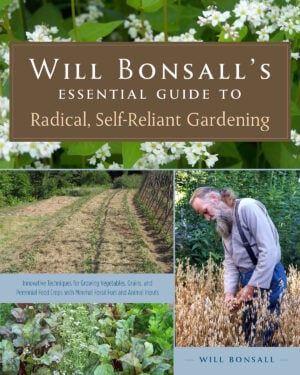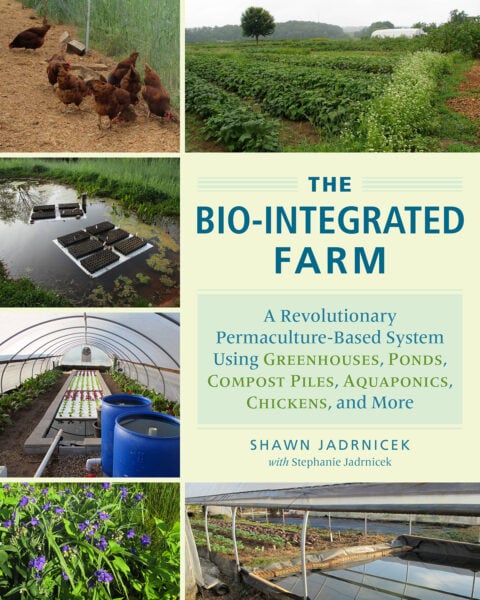Plants & Pests: Will Bonsall’s Advice on “Wee Beasties”
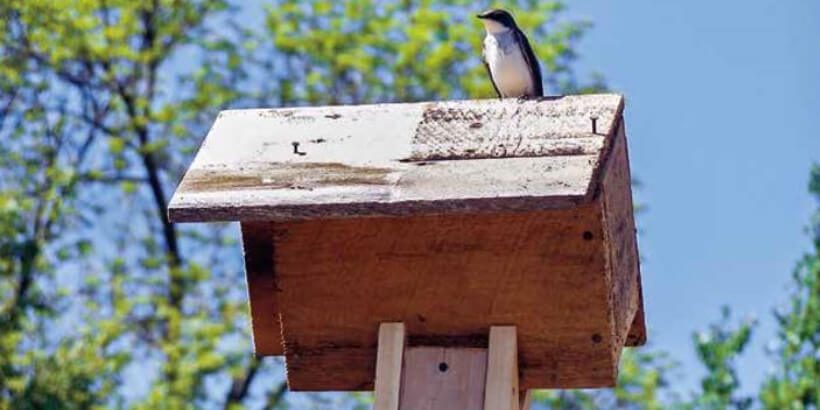
In his book, Bonsall maintains that to achieve real wealth we first need to understand the economy of the land, to realize that things that might make sense economically don’t always make sense ecologically, and vice versa. The marketplace distorts our values, and our modern dependence on petroleum in particular presents a serious barrier to creating a truly sustainable agriculture. Bonsall applies his values to dealing with pests in the garden, namely the “wee beasties.”
The following is an excerpt from Will Bonsall’s Essential Guide to Radical, Self-Reliant Gardening by Will Bonsall. It has been adapted for the web.
From a plant’s point of view there is little difference between a cutworm, a woodchuck, a blight spore, and, for that matter, us.
These are all things that in one way or another prey upon it. It is an inevitable constraint of all living things: We escape one peril only to ultimately succumb to another. Of course there is senescence, the ultimate vulnerability of our own body mechanism. Even if no other organism were to attack us, sooner or later we fall prey to our own frailty: Our bodies quit on us. Not the end of the world, just the end of us as individuals. As long as there are replacements the game goes on.
I feel that a desire for immortality is a symptom of pettiness and ingratitude, and I know for a fact that my cabbages feel the same way. They do not long for eternal life—at least they do not expect it—nor do they aspire to perfect enlightenment. They’re just grateful to be part of it for as long as possible and as fully engaged as possible. Me, too.
There is a theory that if plants grow in a perfectly balanced soil with all their nutrient needs met and with no stress from heat or cold, too much or too little water, then they will be immune to attack from diseases and pests, since pests prefer weak and vulnerable plants. But if so, then wouldn’t they also be immune to attack from us (we prefer to call it harvest)? Anyway the theory can never be more than a theory, because there is no perfect balance in the universe. Rather chaos and change and instability are more the norm; the best we can hope to do is exploit them to our temporary advantage. Should we not strive toward an ideal of perfect harmony? Absolutely! Should we expect to achieve it? Get real. Therefore we must deal with pests.
When we speak of “natural pest control,” or for that matter of “natural farming,” we must bear in mind that there is something inherently unnatural in any kind of farming. Whenever we make a major modification in the landscape, such as converting forests or prairies to croplands, we must constantly struggle to keep them as croplands, because their natural tendency is to revert to whatever they were before people came along. The well-kept gardens we see as so attractive are really gross enormities, straight rows, sometimes whole fields of a single species, often of tropical origin, separated by strips of bare soil such as one would only find in the severest desert.
I know of no agricultural system, including mine, that even approaches the nuanced complexity of a truly natural ecosystem, and therefore it will be chronically unbalanced, simplistic, and vulnerable to a host of pests and diseases. Given our clumsy hubristic attempts at dominating nature, it is remarkable that anything grows there at all. But apparently nature has considerable patience with us, so that even our clumsy efforts to cooperate with it are rewarded far beyond our desserts.
Wee Beasties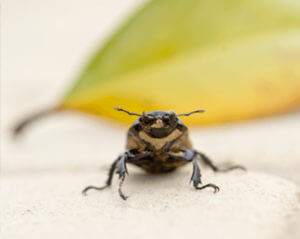
When I say that smaller pests are a proportionately bigger problem, that’s partly because the smaller pests (including insects, slugs, and mites) usually arrive in vast numbers; catching or destroying a few individuals doesn’t accomplish much. The wee beasties tend to come in waves, unlike warm-blooded vertebrates, which typically bother us in flocks or herds or even individually. I suppose that makes a genocidal approach to bugs and insects (not the same) seem more logical, even imperative. Perhaps, but not necessarily. Often the cheapest, simplest, and least invasive remedies are those that merely exclude or repel the invaders.
I suppose when a wave of pests arrives and starves because my plants are inaccessible to them, that is a sort of indirect genocide, though it causes me no angst. Another highly pragmatic reason for avoiding pesticides, even organic natural-ingredient low-toxicity-to-humans pesticides, is that they largely come from the marketplace and involve tropical ingredients or products of the laboratory. None of those is a fatal objection, but it seems that many of the repellents can be homegrown and I always prefer that. Let me give a few examples.
Flea Beetle Remedy
One race of flea beetles used to decimate all of my cruciferas: cabbage family, turnips, mustard, radish. The damage is most severe on the new seedlings; if you can get them past that stage, the vigourous plants can pretty well fend for themselves. However, if they get badly chewed at that vulnerable stage, they will be too weak to rebound and will continue to fall prey. One solution, and a very effective one, is to cover the new seedlings with some sort of row cover, like Reemay. Narrow (24 inches, or 61.0 cm, wide) strips are ample; they can usually be removed as the plants take off, perhaps after as little as two weeks.
There may still be flea beetles around, but their cycle will be broken and the population knocked down to numbers that will inflict little damage. An alternative to Reemay, which comes from oil wells, is Elmer-plantex, which still comes from the marketplace but is made from cotton. Its greatest asset is also its greatest flaw: It is highly biodegradable. You can reuse it several times if you can keep it from getting snagged and torn, and if you can avoid having it in contact with damp soil. I have prolonged its useful life greatly by sandwiching (technically “shrewsburying”) it between two pieces of cheap wooden strapping: the upper piece to anchor it, the lower piece to protect it from wet dirt.
I add occasional stones to pin it tight and keep wind from working it. I sort old pieces into various usable sizes and use each piece appropriately. A problem I have with any row cover is the difficulty of seeing the crop through it (Elmer-plantex is better than Reemay in this respect). If an infestation of aphids or something does break out in there, the beneficial predators are largely excluded, and I may be unaware of a problem until it’s too late. Another very effective remedy is screen-covered frames. These require a much larger investment up front, but can be reused for many years, provided they’re kept under cover in winter.
Removing crop debris from the garden helps control insect pests as well as diseases. I try to be particularly diligent in pulling and shredding all my corn and sunflower stalks soon after they’ve been harvested. This seems to be the best control for corn borers, earworms, and sunflower moth larvae.
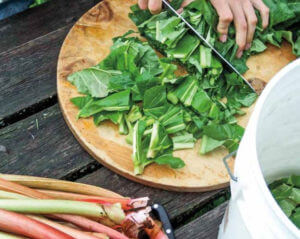 I have another remedy that doesn’t depend on the marketplace and the sea of petroleum: rhubarb. Not the stalks, but the foliage, which ordinarily goes to compost. Of course the leaves are inedible due to toxic levels of oxalic acid, which is the very component we need to repel those flea beetles. I chop up the huge leaves, cover them with boiling water, and simmer for a few minutes before straining. I used to use them raw, for fear that the oxalate might be too heat-labile and lose its pizzazz when boiled. I simply bashed the chopped raw leaves in a bucket with the end of a wooden baseball bat and added tepid water and left it to sit in the warm sun for a day before straining off the decoction. Then I read about boiling it and tried it both ways. I don’t see much difference, and the boiling is more immediate and probably more concentrated.
I have another remedy that doesn’t depend on the marketplace and the sea of petroleum: rhubarb. Not the stalks, but the foliage, which ordinarily goes to compost. Of course the leaves are inedible due to toxic levels of oxalic acid, which is the very component we need to repel those flea beetles. I chop up the huge leaves, cover them with boiling water, and simmer for a few minutes before straining. I used to use them raw, for fear that the oxalate might be too heat-labile and lose its pizzazz when boiled. I simply bashed the chopped raw leaves in a bucket with the end of a wooden baseball bat and added tepid water and left it to sit in the warm sun for a day before straining off the decoction. Then I read about boiling it and tried it both ways. I don’t see much difference, and the boiling is more immediate and probably more concentrated.
The trick to applying it is to use a very fine mist; don’t spray heavily enough for it to bead up and roll off the waxy leaves (especially cabbage). On a bright sunny day, the spray will dry on in minutes and you can spray again. Usually after two or three mistings you will notice a slight glaze on the leaf surfaces and you will know that you have excellent protection, at least until it rains. Even then the effectiveness is not wholly washed off, and that is without adding any “sticker” like fish oil. It is effective for all that family of crop plants.
Another type of flea beetle attacks tomatoes and potatoes. In addition to the damage from feeding, these flea beetles may transmit early blight and various viruses via their mouthparts. I have never tried rhubarb extract on them and don’t know if it would be equally effective. In fact I see no reason why the oxalate glaze, a broad-spectrum irritant, wouldn’t be effective against a whole array of soft-bellied insects, especially their larvae. How silly that I haven’t tried it.
Companion Crops as Deterrents
Other plants also have toxic or irritating properties. One source suggested planting horseradish among your potato plants to repel the Colorado potato beetle. We tried it and saw no pronounced effect, although we didn’t plant very many and what we did plant persisted for years after, long after the potatoes were gone. I have wondered how an extract (infusion) of horseradish root might have worked; I could have applied it more uniformly to all the potato plants, without creating a future weed problem.
Cousin Tom has gotten complete protection from CPBs by spraying tansy tea, but he emphasizes that it is a preventive, not so effective once they’re settled in. We likewise followed directions to plant mint among our cabbage plants, and spent the next two years eradicating mint from successive crops. Again, what if we applied an extract of mint: the essence without the living presence? We recently tried mint oil, mixed with vegetable oil, using a window cleaner bottle-sprayer. If there was any benefit it was offset by the leaf burn caused by the oil spray.
A commercial garlic extract was also of dubious value; would a spray of fresh homegrown garlic be any better? I mean, if it takes an acre of Watsonville garlic to protect half an acre of Maine cabbage, maybe I need to rethink some things. Not saying it does, but in a garden-without-borders we need to ask some pointed questions of the marketplace. Things arising from our own labour and our own ground are more obvious; for better or worse the externalities are all there to see.
Cabbageworm Remedy
Back to the cabbage family: A major pest of the maturing plant is the white cabbage moth. Actually the moths are no problem at all; they hardly think about feeding, so intent are they on laying their eggs, and that’s the problem. Those little green eggs turn into the rubbery, squishy worms that even devout carnivores find off-putting. The worms prefer cabbage and broccoli because those offer the most concealment. Submerging broccoli in salty water for 20 minutes before cooking will force most of them out of hiding, either floating on the water or crawling up the sides of the bowl. But wouldn’t it be nice if they weren’t there in the first place? Again, row covers offer effective exclusion if you’re content with market solutions. We’ve had pretty good results using cedar clippings, though we haven’t done it recently, mainly due to negligence.
To my knowledge all Lepidoptera are uncomfortable around cedar, as well as southern-wood, wormwood, and other artemisias. Of course hot sun will dry these things out pretty quickly, but if you can go through periodically and crumple the sprigs a bit, it will release more essential oil (which is tied up in the woody fibres). Also it is easily and cheaply replaced. We mostly placed the cedar sprigs on the ground around the plants, but in retrospect I’m sure we should have laid them right over the plants, especially the developing heads of broccoli. Of course there is always Bt, which is a wonderful organic remedy, but again I am focusing on my own solutions that aren’t birthed in a laboratory.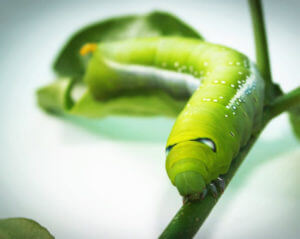
Recruiting Beneficials
Just as I recruit skunks and weasels to control my rodent pests, there are plenty of beneficial insects, nematodes, and microbes that can control our buggy enemies. I am always somewhat loath to import critters that cannot become endemic but will die out and need to be replaced. Not only am I reluctant to forge yet another link in the chain to the marketplace, but somehow I hate to think of sending my allies to their doom. On the other hand there are plenty of beneficials that aren’t in my garden simply because they haven’t found their way here yet or that are already here and merely need favourable conditions to expand their presence. The wet area below my pond is always a favourite breeding place for fireflies. How nice that they flit about flashing their sex-lights on July evenings; how nicer still that they have a voracious appetite for slugs!
Saving seed plants of second-year biennials like parsnip is a great idea, though I need only so much parsnip seed. The plants also serve as a nectary for syrphid wasps, which at other times are heavy predators on aphids and numerous other pests. It all works together. The kind of ladybugs that are common here now are not the same species that was here decades ago. Both species are here now, but the new is larger and I’ve heard is a more voracious eater of aphids. Since they can survive here without any help, I welcome them both.
Bug Juice
One radical pest remedy is highly genocidal, but also very funky and homegrown—I’m sure they do this in Esperia—although I haven’t used it myself, which is absurd. The so-called bug juice method requires only a dedicated blender, perhaps one of those smoothie makers you see at yard sales. You will not want to use this one for anything else. You capture a number of pests, especially beetles (although this supposedly works for a huge assortment of pests), and put them in a cup or two of water in the blender. You liquefy them, strain, add more water, and set the “juice” in a warm place for several hours, although some sources recommend applying it immediately with a backpack sprayer.
I’ve heard that it doesn’t work, and I’ve also heard that it works extremely well for a wide range of pests, including Japanese beetles, Colorado potato beetles, and Mexican bean beetles. I suppose for flea beetles the difficulty would be collecting enough of the tiny specks to suffice, and are they too tiny to liquefy? I guess the concept is obvious here: We all have the seeds of our own destruction within us, especially in our lower guts. Release all that, allow it to fester, and inoculate our surroundings with it, especially our food… well, you get the picture.
I have also heard that the bug juice doesn’t actually kill the pests (other than those you liquefy), but merely repels them. I’m sure it does that, but I can’t imagine it doesn’t also cause them grievous bodily harm. I have noticed that when I have gone through the potato patch, squishing CPBs here and there, successive immigrants seem to avoid those areas, although perhaps they just prefer the new healthy growth.
I believe that for every tip I’ve mentioned here, there are 20 more that would be just as effective or better. What other aromatic plants, herbs, or conifers contain oils or irritants that are offensive to certain pests? After all, most of these substances are produced by plants to protect themselves; mightn’t the less well-armed neighbors benefit by the proximity to those powerful natural defenses?
Recommended Reads
Recent Articles
Asparagus is a delicious vegetable with a layered history. How did this aspiring spear make its way from growing in the wild to appearing on our plates? The following is an excerpt from the The Seed Detective by Adam Alexander. It has been adapted for the web. “Nature gives us the key to every secret…
Read MoreInterested in growing trees? Here are some tips on successfully planting, transplanting, and pruning trees to create a flourishing forest garden! The following is an excerpt from The Home-Scale Forest Garden by Dani Baker. It has been adapted for the web. Planting Potted Trees and Shrubs If you order potted trees, check with your supplier to…
Read MoreWith the right strategies and practices, composting on a small farm is surprisingly easy and inexpensive. Just follow these steps for making compost, and your farm will be thriving in no time! The following excerpt is from The Lean Farm Guide to Growing Vegetables by Ben Hartman. It has been adapted for the web. (All photographs by Ben…
Read MoreGarlic mustard: while known as “invasive,” this plant can be consumed in its entirety and has great nutritional value. Plus, the garlic-flavor is a perfect addition to any recipe that calls for mustard! The following are excerpts from Beyond the War on Invasive Species by Tao Orion and The Wild Wisdom of Weeds by Katrina…
Read MoreEveryone loves a refreshing, fermented, nutritious drink…even your garden! Take your fermentation skills out of the kitchen and into the garden by brewing fermented plant juice. The following is an excerpt from The Regenerative Grower’s Guide to Garden Amendments by Nigel Palmer. It has been adapted for the web. How to Make Fermented Plant Juice Fermented…
Read More

